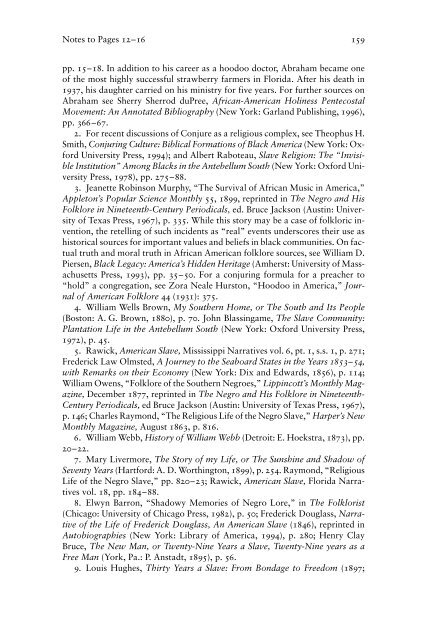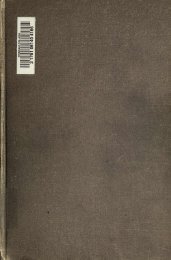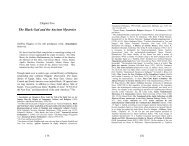Black Magic: Religion and the African American Conjuring Tradition ...
Black Magic: Religion and the African American Conjuring Tradition ...
Black Magic: Religion and the African American Conjuring Tradition ...
Create successful ePaper yourself
Turn your PDF publications into a flip-book with our unique Google optimized e-Paper software.
Notes to Pages 12–16 159<br />
pp. 15–18. In addition to his career as a hoodoo doctor, Abraham became one<br />
of <strong>the</strong> most highly successful strawberry farmers in Florida. After his death in<br />
1937, his daughter carried on his ministry for five years. For fur<strong>the</strong>r sources on<br />
Abraham see Sherry Sherrod duPree, <strong>African</strong>-<strong>American</strong> Holiness Pentecostal<br />
Movement: An Annotated Bibliography (New York: Garl<strong>and</strong> Publishing, 1996),<br />
pp. 366–67.<br />
2. For recent discussions of Conjure as a religious complex, see Theophus H.<br />
Smith, <strong>Conjuring</strong> Culture: Biblical Formations of <strong>Black</strong> America (New York: Oxford<br />
University Press, 1994); <strong>and</strong> Albert Raboteau, Slave <strong>Religion</strong>: The “Invisible<br />
Institution” Among <strong>Black</strong>s in <strong>the</strong> Antebellum South (New York: Oxford University<br />
Press, 1978), pp. 275–88.<br />
3. Jeanette Robinson Murphy, “The Survival of <strong>African</strong> Music in America,”<br />
Appleton’s Popular Science Monthly 55, 1899, reprinted in The Negro <strong>and</strong> His<br />
Folklore in Nineteenth-Century Periodicals, ed. Bruce Jackson (Austin: University<br />
of Texas Press, 1967), p. 335. While this story may be a case of folkloric invention,<br />
<strong>the</strong> retelling of such incidents as “real” events underscores <strong>the</strong>ir use as<br />
historical sources for important values <strong>and</strong> beliefs in black communities. On factual<br />
truth <strong>and</strong> moral truth in <strong>African</strong> <strong>American</strong> folklore sources, see William D.<br />
Piersen, <strong>Black</strong> Legacy: America’s Hidden Heritage (Amherst: University of Massachusetts<br />
Press, 1993), pp. 35–50. For a conjuring formula for a preacher to<br />
“hold” a congregation, see Zora Neale Hurston, “Hoodoo in America,” Journal<br />
of <strong>American</strong> Folklore 44 (1931): 375.<br />
4. William Wells Brown, My Sou<strong>the</strong>rn Home, or The South <strong>and</strong> Its People<br />
(Boston: A. G. Brown, 1880), p. 70. John Blassingame, The Slave Community:<br />
Plantation Life in <strong>the</strong> Antebellum South (New York: Oxford University Press,<br />
1972), p. 45.<br />
5. Rawick, <strong>American</strong> Slave, Mississippi Narratives vol. 6, pt. 1, s.s. 1, p. 271;<br />
Frederick Law Olmsted, A Journey to <strong>the</strong> Seaboard States in <strong>the</strong> Years 1853–54,<br />
with Remarks on <strong>the</strong>ir Economy (New York: Dix <strong>and</strong> Edwards, 1856), p. 114;<br />
William Owens, “Folklore of <strong>the</strong> Sou<strong>the</strong>rn Negroes,” Lippincott’s Monthly Magazine,<br />
December 1877, reprinted in The Negro <strong>and</strong> His Folklore in Nineteenth-<br />
Century Periodicals, ed Bruce Jackson (Austin: University of Texas Press, 1967),<br />
p. 146; Charles Raymond, “The Religious Life of <strong>the</strong> Negro Slave,” Harper’s New<br />
Monthly Magazine, August 1863, p. 816.<br />
6. William Webb, History of William Webb (Detroit: E. Hoekstra, 1873), pp.<br />
20–22.<br />
7. Mary Livermore, The Story of my Life, or The Sunshine <strong>and</strong> Shadow of<br />
Seventy Years (Hartford: A. D. Worthington, 1899), p. 254. Raymond, “Religious<br />
Life of <strong>the</strong> Negro Slave,” pp. 820–23; Rawick, <strong>American</strong> Slave, Florida Narratives<br />
vol. 18, pp. 184–88.<br />
8. Elwyn Barron, “Shadowy Memories of Negro Lore,” in The Folklorist<br />
(Chicago: University of Chicago Press, 1982), p. 50; Frederick Douglass, Narrative<br />
of <strong>the</strong> Life of Frederick Douglass, An <strong>American</strong> Slave (1846), reprinted in<br />
Autobiographies (New York: Library of America, 1994), p. 280; Henry Clay<br />
Bruce, The New Man, or Twenty-Nine Years a Slave, Twenty-Nine years as a<br />
Free Man (York, Pa.: P. Anstadt, 1895), p. 56.<br />
9. Louis Hughes, Thirty Years a Slave: From Bondage to Freedom (1897;




